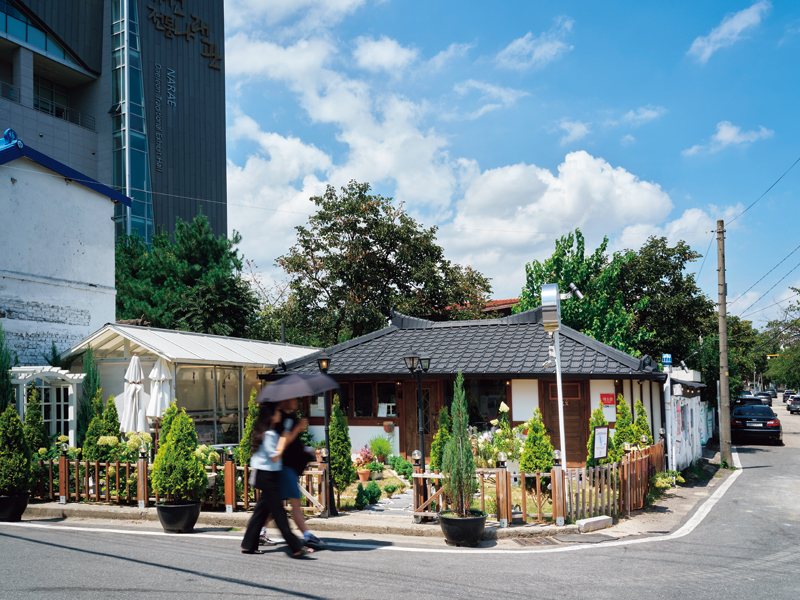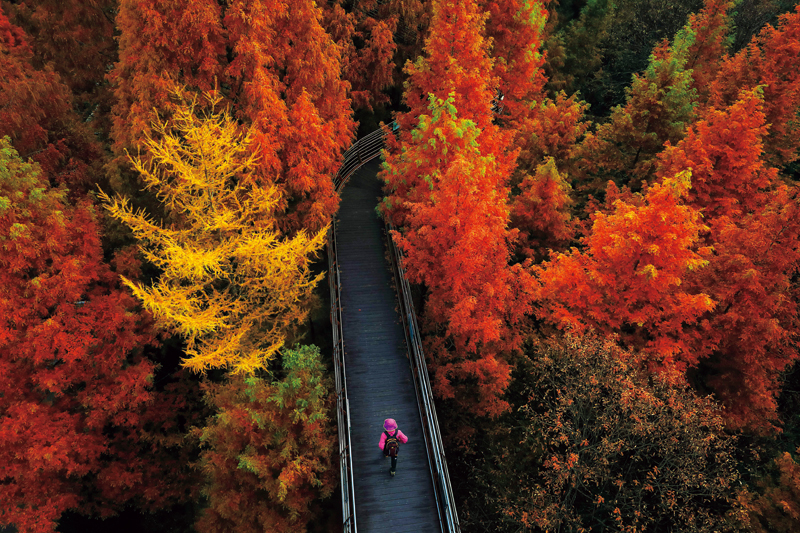Daejeon is where you go to see Korea’s next innovations being hatched, eat some of the best bread in the country, and explore an old railroad workers’ village, where houses have been turned into popular cultural spaces. Having shed its past image as dull, the city now offers lots to explore and enjoy.

© Daejeon Tourism Organization
Over the past century, few cities in Korea have changed on the same scale as Daejeon. A combination of new infrastructure, international aid, a national emphasis on STEM fields (science, technology, engineering, and mathematics), and the relocation of government offices from Seoul have redefined the city. Daejeon’s transformation stems largely from its ideal location and geography — a plain in South Korea’s midlands. The city’s old name was Hanbat, which means “large field,” and up until the early 20th century it was a sparsely populated village. Then railroad building in the colonial era turned Daejeon into an easily accessible transportation hub. Roads, rail lines, and waterways connected the city to all parts of the country.
Railway workers lived in a neighborhood called Soje-dong, near Daejeon Station. In the wake of the Korean War and construction of new residential zones, Soje-dong was largely neglected and more than 2,000 houses were left vacant. Change began in 2010 when an artist repurposed a railway worker’s old residence into a cultural space.
Today, Soje-dong is emblematic of Koreans’ fascination with all things “newtro,” a portmanteau of the words “new” and “retro.” At first glance, the neighborhood might appear old and shabby, but its true charm is revealed when you venture into the narrow alleyways. It doesn’t take long to appreciate how the houses have gotten a new lease on life. From a café with a lush bamboo grove serving as the front entrance to a restaurant with a beautiful garden that is reminiscent of hot springs, the blend of original concepts and modern design creates a distinctive ambiance.

Former residences of railroad workers in Soje-dong have been turned into cafés and other small establishments. Each house has been repurposed in its own distinct style, while retaining the original roofs, ceilings, and pillars.
Similarly, Temi Orae is a village with public officials’ residences that were built in the 1930s in Daejeon’s old downtown area. Nine of them, including the former house of the South Chungcheong Province governor, have been remodeled and turned into a cultural space, which holds exhibitions on Daejeon’s modern history, art, and culture.
Once considered rather dull due to a lack of tourist attractions and its work-intense atmosphere, Daejeon has evolved into a fun city with theater festivals and singing contests amid new cafés, restaurants, and galleries.
SCIENCE AND INNOVATION HUB
While Daejeon has long been a vital transportation hub, over the past 50 years it has become better known as Korea’s cradle for high-tech breakthroughs. As the sprawling city’s boundary expanded, it incorporated the town of Daedeok in 1983. By then, a central government decision to centralize national research and development institutions had led to the creation of the Daedeok Research Complex in 1973. Now called Innopolis Daedeok, it is the largest center of its kind in Korea.

The Expo Science Park includes the Daejeon Expo Memorial Hall, the Mulbit Square music fountain, and the landmark Hanbit Tower. Locals and visitors like to relax in the shade of the trees or enjoy the beautiful nightscape.
© Shin Jung-sik
As of the end of December 2022, there were 2,397 research institutes and companies in Daedeok. In addition, Daejeon is home to more than twenty universities and colleges, including the prestigious Korea Advanced Institute of Science and Technology (KAIST), and the research headquarters of leading conglomerates. This innovation hub and high-tech incubator has played a pivotal role in boosting Korea’s scientific competitiveness. Thus, any conversation about future high-tech applications starts with what is happening in Daejeon.
In 1993, Daejeon played host to the World Expo, an event that rivaled the scale of the 1988 Seoul Olympics, with participation from 108 countries, 33 international organizations, and more than 200 Korean companies. It made Daejeon synonymous with science. The Expo Science Park, at the World Expo site, now serves as a landmark and leisure place for residents and visitors. The Expo Hanbit Tower is a favorite spot to view the beautiful nightscape. Further bolstering its academic profile, Daejeon hosted the International Mathematic Olympiad in 2000.
The National Science Museum, in the heart of Innopolis Daedeok, offers hands-on experiences that make science more approachable. It is a place where the past, present, and future converge, captivating visitors with exhibits that include a full-scale model of Naro-1, Korea’s first space launch vehicle, and a robot version of Kumdori, the 1993 World Expo mascot.

Learning is fun at the National Science Museum, which has interactive exhibits encompassing science & technology, natural history, human evolution, astronomy, and future technology.
WHEAT FLOUR ALTERS CUISINE
Korean noodles were traditionally made from buckwheat flour and arrowroot starch. This changed when wheat flour entered Korea in the mid-1950s. The Korean War had ravaged the country, leading to a severe shortage of rice, the Korean staple. The government encouraged people to mix rice with other ingredients, such as the wheat and corn donated by the U.S. Putting wheat noodles in popular broth-based dishes, such as seolleongtang (ox bone soup) or dwaejigukbap (pork soup with rice), became common and remains a vestige of the era.
Wheat flour became a feature of Daejeon’s culinary tradition when the city grew into an interim storage and distribution center for U.S. commodities, including grains that were milled there after arriving at the ports of Busan or Incheon. It became so abundant that it served as a form of currency. Laborers who worked on the land reclamation project to the west of Daejeon in the 1960s and 1970s were paid with wheat flour, which could be converted to cash at an exchange center.
Its abundance led to the development of new dishes. A quintessential Korean soul food that originated in Daejeon is kalguksu, a soup made with seafood- or meat-based broth, wheat noodles, and vegetables. There are many variations with differences in the broth, garnish, and the thickness of the noodles.
Kalguksu is a popular dish available in restaurants nationwide. There are no records proving by whom and exactly where in Daejeon it was created, but in the 1960s, “Daejeon kalguksu” began appearing in the media. Befitting its reputation as the dish’s birthplace, there were as many as 727 kalguksu restaurants in Daejeon by the end of 2023, which equates to five per 10,000 people, the largest number in a single locale. Daejeon has also been hosting a kalguksu festival every October since 2017.

Noodles in broth made from beef bones and anchovies. As the birthplace of kalguksu, Daejeon has many restaurants specializing in different versions of the popular noodle dish.
© Shin Jung-sik
LEADING BAKERY
Daejeon has more food to boast than just kalguksu. Sungsimdang, based in the city, is the leading non-franchise bakery in Korea. In 2023, it reported 124.3 billion won in sales and a net profit of 31.5 billion won, about 93 and 24 million dollars, respectively.
Sungsimdang opened its doors in 1956, the year U.S. wheat shipments began arriving. Founder Lim Gil-soon and his wife Han Sun-deok had fled from the North to the South during the Korean War and eventually settled in Daejeon. After receiving two sacks of wheat flour from a Catholic priest, the couple started selling steamed buns.
Memories of postwar hardship have never been forgotten. Every day, the bakery donates leftover bread to orphanages and welfare centers, a practice it began the first day it opened. If there isn’t enough, more bread is baked fresh.
Sungsimdang shows a passionate commitment to product development, coming out with one-of-a-kind pastries such as the fried soboro ppang. This is a type of bun with a streusel topping, combining the sweetness of red bean bread, the nutty flavor of a streusel bun, and the crispy texture of a donut. It has become one of Sungsimdang’s standout products, with more than 80 million sold to date; needless to say, the recipe is patented.

Sungsimdang, Daejeon’s iconic bakery, is always crowded, with long lines of people waiting to get inside to buy its signature offerings, such as siru cake, popular for its generous topping of seasonal fruits.
While walking through downtown Daejeon, if you happen to spot a long line of people stretching tens or even hundreds of meters, you’ve most likely stumbled upon a Sungsimdang store. Since the bakery only has locations in Daejeon, visiting the city is the only way to taste its goods.
The large number of kalguksu restaurants and the long queues outside Sungsimdang stores attest to how wheat flour, which helped satiate the hunger of struggling Koreans long ago, has transformed Daejeon from a bland city to a delicious city. The annual Daejeon Bread Festival, held for two days in late September, showcases the city’s pride in its delectable offerings.
CULTURAL AND NATURAL ATTRACTIONS
To think of Daejeon as merely a transportation hub with great food would not do justice to a city that is also rich in culture and nature.
One of Daejeon’s most popular attractions is the Hanbat Arboretum in the heart of the city, the largest urban arboretum in the country. Adjacent are the Daejeon Museum of Art and the Lee Ungno Museum. Lee Ungno (1904–1989) is renowned for his abstract paintings that incorporate elements of calligraphy, such as his Abstract Letter and People series. In his fifties, at the height of fame and fortune, he moved to Paris to explore new artistic possibilities.

The Lee Ungno Museum in Daejeon offers deep insights into the artist’s creative world, a blend of East and West, traditional and contemporary.
ⓒ ARCHFRAME.NET
Even after becoming embroiled in a political incident in the late 1960s and suffering hardships as a consequence, Lee continued to create. While incarcerated in the Daejeon Correctional Institution for two and a half years, he produced over 300 works, using any available material, including grains of rice.
Far from crushing his spirit, the period saw Lee continue to pursue art that could transcend borders. The People series, to which Lee devoted himself in the late 1970s, resonated with people around the world. The paintings depict crowds of people gathered as if engaged in a dance. Koreans discovered in them the energy that spurred the country’s democratization.
The many layers Daejeon has accumulated over the last century through constant change and effort now allow it to cater to a broad range of interests, whether it be science, culture, modern and contemporary history, art, or nature. To truly appreciate all the city has to offer, it is best to invest more than a day or two and pick a theme for each day.

Jangtaesan Natural Forest is home to a dense area of metasequoias, a rarity in Korea, where visitors can enjoy forest bathing surrounded by stunning scenery.
© KOREA TOURISM ORGANIZATION